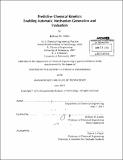| dc.description.abstract | The use of petroleum-based fuels for transportation accounted for more than 25% of the total energy consumed in 2012, both in the United States and throughout the world. The finite nature of world oil reserves and the effects of burning petroleum-based fuels on the world's climate have motivated efforts to develop alternative, renewable fuels. A major category of alternative fuels is biofuels, which potentially include a wide variety of hydrocarbons, alcohols, aldehydes, ketones, ethers, esters, etc. To select the best species for use as fuel, we need to know if it burns cleanly, controllably, and efficiently. This is especially important when considering novel engine technologies, which are often very sensitive to fuel chemistry. The large number of candidate fuels and the high expense of experimental engine tests motivates the use of predictive theoretical methods to help quickly identify the most promising candidates. This thesis presents several contributions in the areas of predictive chemical kinetics and automatic mechanism generation, particularly in the area of reaction kinetics. First, the accuracy of several methods of automatic, high-throughput estimation of reaction rates are evaluated by comparison to a test set obtained from the NIST Chemical Kinetics Database. The methods considered, including the classic Evans-Polanyi correlation, the "rate rules" method currently used in the RMG software, and a new method based on group contribution theory, are shown to not yet obtain the order-of-magnitude accuracy desired for automatic mechanism generation. Second, a method of very accurate computation of bimolecular reaction rates using ring polymer molecular dynamics (RPMD) is presented. RPMD rate theory enables the incorporation of quantum effects (zero-point energy and tunneling) in reaction kinetics using classical molecular dynamics trajectories in an extended phase space. A general-purpose software package named RPMD-rate was developed for conducting such calculations, and the accuracy of this method was demonstrated by investigating the kinetics and kinetic isotope effect of the reaction OH + CH4 --> CH3 + H2O. Third, a general framework for incorporating pressure dependence in thermal unimolecular reactions, which require an inert third body to provide or remove the energy needed for reaction via bimolecular collisions, was developed. Within this framework, several methods of reducing the full, master equation-based model to a set of phenomenological rate coefficients k(T, P) are compared using the chemically-activated reaction of acetyl radical with oxygen as a case study, and recommendations are made as to when each method should be used. This also resulted in a general-purpose code for calculating pressure-dependent kinetics, which was applied to developing an ab initio model of the reaction of the Criegee biradical CH 200 with small carbonyls that reproduces recent experimental results. Finally, the ideas and techniques of estimating reaction kinetics are brought together for the development of a detailed kinetics model of the oxidation of diisopropyl ketone (DIPK), a candidate biofuel representative of species produced from cellulosic biomass conversion using endophytic fungi. The model is evaluated against three experiments covering a range of temperatures, pressures, and oxygen concentrations to show its strengths and weaknesses. Our ability to automatically generate this model and systematically improve its parameters without fitting to the experimental results demonstrates the validity and usefulness of the predictive chemical kinetics paradigm. These contributions are available as part of the Reaction Mechanism Generator (RMG) software package. | en_US |
